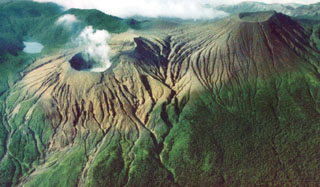Report on Rincon de la Vieja (Costa Rica) — 17 May-23 May 2023
Smithsonian Institution / US Geological Survey
Weekly Volcanic Activity Report, 17 May-23 May 2023
Managing Editor: Sally Sennert.
Please cite this report as:
Global Volcanism Program, 2023. Report on Rincon de la Vieja (Costa Rica) (Sennert, S, ed.). Weekly Volcanic Activity Report, 17 May-23 May 2023. Smithsonian Institution and US Geological Survey.
Rincon de la Vieja
Costa Rica
10.83°N, 85.324°W; summit elev. 1916 m
All times are local (unless otherwise noted)
OVSICORI-UNA reported that small phreatic eruptions periodically occurred at Rincón de la Vieja during 16-23 May. Four small events occurred during 16-17 May; the last one, recorded at 1255 on 17 May, produced a gas-and-steam plume that rose 700 m above the crater rim. Sulfur dioxide emissions were almost as high as 5,000 tonnes per day on 17 May; emissions averaged around 132 tonnes per day during the previous week. Events were recorded at 1537 on 18 May and at 0727 and 1025 on 19 May. Vigorous gas emissions were visible in the early morning of 20 May and a phreatic event occurred at 1648 that same day. At 1349 a phreatic event generated a plume mostly comprised of steam that rose 1 km above the crater rim.
Geological Summary. Rincón de la Vieja, the largest volcano in NW Costa Rica, is a remote volcanic complex in the Guanacaste Range. The volcano consists of an elongated, arcuate NW-SE-trending ridge constructed within the 15-km-wide early Pleistocene Guachipelín caldera, whose rim is exposed on the south side. Sometimes known as the "Colossus of Guanacaste," it has an estimated volume of 130 km3 and contains at least nine major eruptive centers. Activity has migrated to the SE, where the youngest-looking craters are located. The twin cone of Santa María volcano, the highest peak of the complex, is located at the eastern end of a smaller, 5-km-wide caldera and has a 500-m-wide crater. A Plinian eruption producing the 0.25 km3 Río Blanca tephra about 3,500 years ago was the last major magmatic eruption. All subsequent eruptions, including numerous historical eruptions possibly dating back to the 16th century, have been from the prominent active crater containing a 500-m-wide acid lake located ENE of Von Seebach crater.
Source: Observatorio Vulcanologico y Sismologico de Costa Rica-Universidad Nacional (OVSICORI-UNA)

